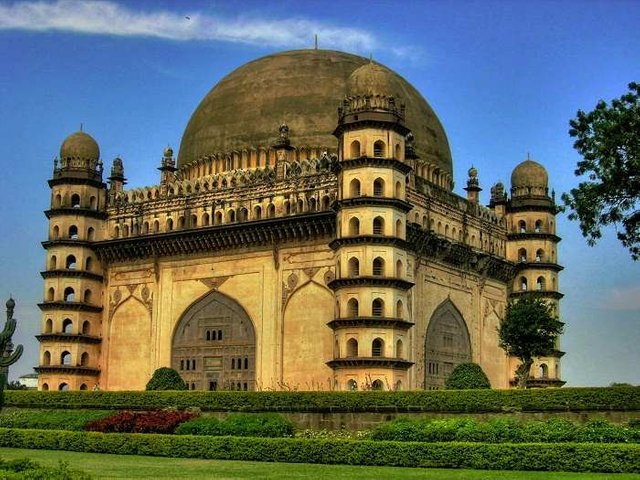Gol Gumbaz
Construction Started : 1626 AD
Construction Completed : 1656 AD
Maintained By : Archeological Survey of India (ASI)
Where is it Located : Bijapur, Karnataka, India
Why was it Built : To mark the tomb of Mohammed Adil Shah
Dimensions : 47.5 metres (156 ft) on each side, capped by a dome 44 m (144 ft) in external diameter
Materials Used : Dark grey basalt
Architectural Style : Deccan Indo-Islamic
Designer : Yaqut of Dabul
Visit Timing :10:00 AM to 5:00PM, all days of the week
Entry Fee : Rs. 10/- for Indian nationals and Rs. 100/- for Foreign nationals
How to Reach : The nearest airport is in the town of Belgaum which is 205 KM from Bijapur. Well connected by road with Bangalore, Pune and Hyderabad, overnight journey in bus or car takes you to this monument. There are 10 and 7 numbers of weekly trains to Bijapurfrom Bengaluru and Pune respectively.Once inside the town, tourists can avail taxis or autos or may be horse-drawn carriages (tangas) if they are feeling adventurous. Mohammed Adil shah started construction of his own tomb to bury his mortal remains right after his ascent to the throne in 1626. Mohammed Adil shah intended to build for himself a mausoleum comparable and possibly grander in scale than the Ibrahim Rauza, the tomb of his father, Ibrahim Adil Shah II. The composition and ornamentation of the Ibrahim Rauza is exceptionally intricate and beautiful. Going for size, the Gol Gumbaz was planned as a mammoth single chamber structure and remains one of the biggest in the world till date. The construction of the tomb continued throughout Mohammed Adil Shah’s regime but could not be executed to full extent due to the sudden demise of the Sultan in 1656. Buried along with the Sultan are his two wives, Taj Jahan Begum and Aroos Bibi, his mistress Rambha, his daughter and his grandson.
Mohammed Adil shah started construction of his own tomb to bury his mortal remains right after his ascent to the throne in 1626. Mohammed Adil shah intended to build for himself a mausoleum comparable and possibly grander in scale than the Ibrahim Rauza, the tomb of his father, Ibrahim Adil Shah II. The composition and ornamentation of the Ibrahim Rauza is exceptionally intricate and beautiful. Going for size, the Gol Gumbaz was planned as a mammoth single chamber structure and remains one of the biggest in the world till date. The construction of the tomb continued throughout Mohammed Adil Shah’s regime but could not be executed to full extent due to the sudden demise of the Sultan in 1656. Buried along with the Sultan are his two wives, Taj Jahan Begum and Aroos Bibi, his mistress Rambha, his daughter and his grandson.